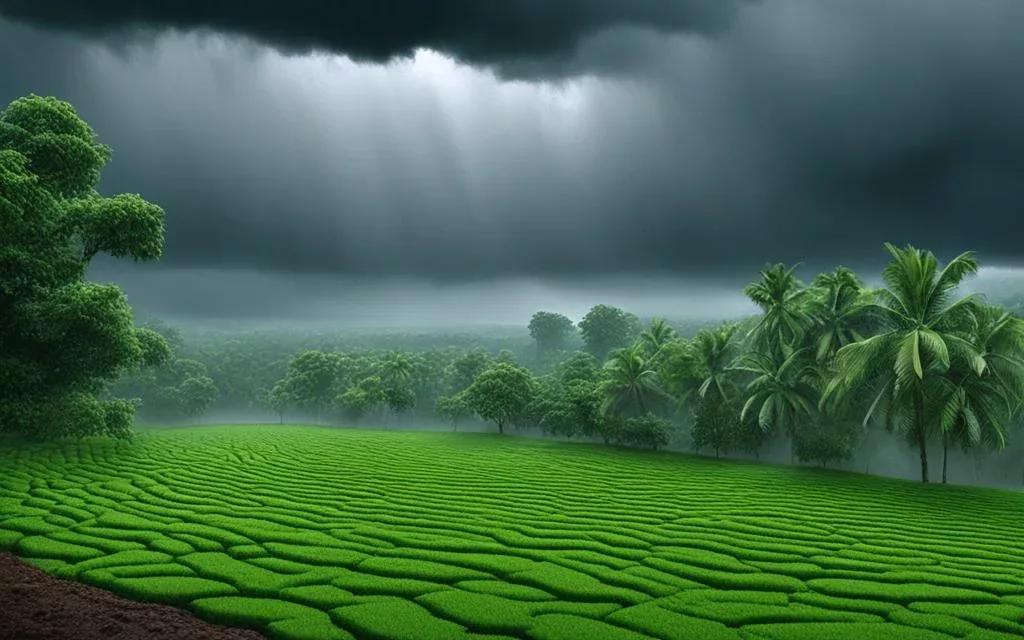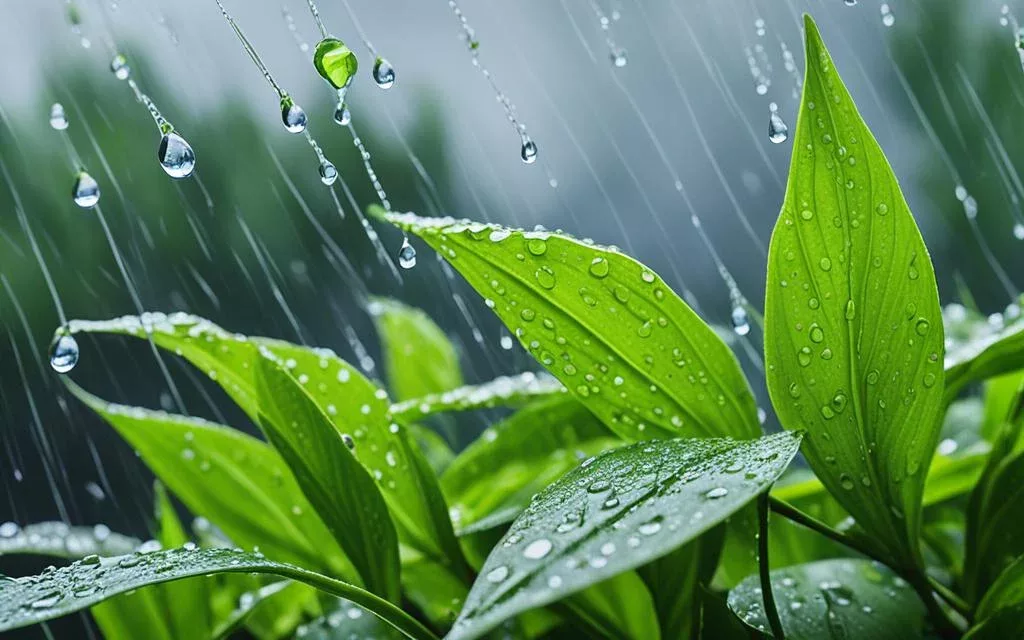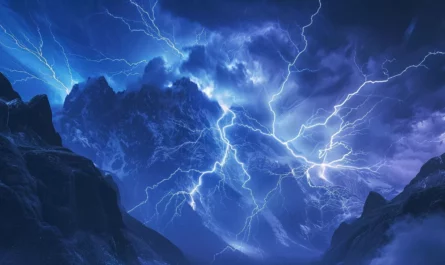Did you know monsoons bring heavy rainfall to Asia? These seasonal winds affect the atmosphere and set rainfall patterns. They happen from West Africa to South America, impacting many areas.
Monsoons mean more than just wind and rain. They hold value in many Asian cultures. The word “monsoon” came from British India to describe the winds that cool off hot summers. They’re part of history and stories, showing how nature connects with people.
We will dive into how monsoon winds work and their effects. We’ll look at their impact in places like Northwestern Mexico, the U.S. Southwest, and India. Understanding monsoons helps us see their role in the climate.
Monsoons also help plants grow and have shaped Asian history. But, they bring challenges that require adapting. Join us as we uncover the role of monsoons in our world.
Understanding the Patterns of Monsoon Winds in Asia
Monsoon winds in Asia come from the Intertropical Convergence Zone (ITCZ). This is a low-pressure belt that moves above and below the equator. These winds carry moisture from the Pacific Ocean and the Gulf of California. Thus, they cause heavy rain during monsoon season.
The Asian monsoon is shaped by many things. The Tibetan Plateau plays a big role. It works like a barrier, changing how monsoon winds move. The high land makes the air move in a way that brings more rain to Asia during monsoon.
In summer, monsoon winds in Asia blow from the southwest. But in winter, they come from the northeast. This switch causes the wet and dry seasons in many Asian areas.
Climate change and ice age cycles have changed monsoon winds in Asia over time. Global warming alters air movements, affecting monsoon patterns. Researchers are trying to understand what this means for Asia’s future climate.
Monsoon Winds in Asia: An Intricate Dance of Atmospheric Forces
“The dance of monsoon winds in Asia shows nature’s strength. The mix of the Intertropical Convergence Zone, the Tibetan Plateau’s rise, and climate changes creates a balance. This balance decides when and how heavy the monsoon rains will be in the area.”
| Monsoon Season | Wind Direction | Impact |
|---|---|---|
| Summer Monsoon | Southwest | Brings heavy rainfall, replenishes water sources, and supports agriculture |
| Winter Monsoon | Northeast | Brings dry and cooler weather, affecting agricultural activities |
The dance of monsoon winds shapes Asia’s climate. It affects water resources, farming, ecosystems, and lives of millions. Knowing these patterns helps manage land and water better. It aids in planning for the future in monsoon areas.
We’ll learn more about monsoons’ effects on Northwestern Mexico and the U.S. Southwest next.
Impact of Monsoon Rains on Northwestern Mexico and the U.S. Southwest
The North American Monsoon greatly affects northwestern Mexico and the U.S. Southwest. It changes air movement and rain patterns there. The season starts in June in Mexico and reaches the U.S. Southwest by July.
For northwestern Mexico, this rainfall is a big deal. It brings most of the year’s rain. Monsoon showers refill water sources, help farms, and boost the whole area’s nature scene.
In these areas, monsoon rains also help stop wildfires. More moisture in the ground and plants means fires are less likely. This protects wildlife and homes alike.
Besides, these rains fight drought by refilling water spots. This ensures people and nature have enough water to thrive during dry spells.
The North American Monsoon’s effects go beyond local areas. It plays a significant role in the entire climate system. It shapes weather patterns, temperatures, and air dynamics nearby.
“The monsoon rains bring much-needed relief from the dry conditions, supporting agriculture, replenishing water sources, and reducing the risk of wildfires. They are a lifeline for the region.”
Conservation Measures
Seeing how crucial monsoon rains are here, it’s important to look after this ecosystem. Conservation work is essential. Efforts include water management, habitat protection, eco-friendly farming, and teaching communities about conservation.
- Implementing water management strategies to optimize water usage and reduce wastage
- Protecting and restoring critical habitats to preserve biodiversity and ecosystem services
- Encouraging sustainable agricultural practices that minimize water consumption and promote soil conservation
- Education and awareness programs to promote responsible water usage and conservation practices in local communities
By focusing on conservation, we can keep enjoying the monsoon’s benefits. This helps protect the unique ecosystems and communities that need them.
Importance of Monsoon Rains in India
Monsoon rains bring an end to high temperatures in India. Starting in early June, they bring relief from the heat. They also support agriculture and refill water sources, helping the ecosystem.

Farmers look forward to the monsoon rains. The rains refresh the soil and help crops grow. These crops are vital to the Indian diet.
“The monsoon is a lifeline for our agriculture. It brings life to our fields and ensures a good harvest. We depend on the monsoon for our livelihood,” says Rajesh Kumar, a farmer from Punjab.
The monsoons refill rivers, lakes, and reservoirs. This meets the water needs of people all year round. They also boost groundwater levels, crucial for water and irrigation.
For humans and the environment, the monsoon season is key. It supports many plants and animals. Many species rely on the rain for their life cycles.
Conservation is important to use monsoon rains well. Efforts like rainwater harvesting and afforestation are crucial. They help manage the benefits of the monsoon.
Conservation Efforts in India
India has taken steps to make the most of monsoon rains. These include:
- Using traditional structures to collect rain and recharge groundwater.
- Watershed management programs help control soil erosion.
- Afforestation projects increase green cover.
- Teaching farmers efficient water use and promoting advanced irrigation methods.
Through these efforts, India is boosting its ability to handle monsoon changes. It’s ensuring sustainable use of monsoon rains for the future.
Monsoon rains are crucial for India. They cool down the heat, help with farming, refill water sources, and keep biodiversity thriving. They give hope and support to many.
| Impact of Monsoon Rains in India | Beneficiaries |
|---|---|
| Enhanced agricultural productivity | Farmers, agricultural workers, and the entire population dependent on food production |
| Increased water availability | Rural and urban populations, industries, and ecosystems |
| Promotion of biodiversity | Flora and fauna in various ecosystems |
| Improved groundwater levels | Communities dependent on groundwater for drinking water and irrigation |
Monsoons in Relation to Climate Change
Climate change is impacting monsoons, changing how rain falls during these seasons. The IPCC Sixth Assessment Report shows that since the 1970s, monsoon rains have gotten heavier because of greenhouse gases. But, scientists are not sure how this will change in the future, except for monsoons starting and ending later.
Warmer weather makes more water evaporate and dries out the soil when it’s not raining. This affects areas that depend on the monsoon. It changes farming, water supplies, and natural habitats.
“Climate change poses challenges for monsoon regions, exacerbating the already unpredictable nature of monsoons. Adaptation strategies and sustainable practices are essential for mitigating the effects of climate change and ensuring the resilience of these regions.”
Conservation is key to dealing with climate change effects on monsoons. We can protect monsoons by living more sustainably and lowering greenhouse gases. This helps keep nature in balance and maintains monsoon patterns.
| Impacts of Climate Change on Monsoons | Adaptation Strategies |
|---|---|
| Increase in intense rainfall events | Implementing robust drainage systems to mitigate floods |
| Changes in monsoon timing and duration | Adjusting agricultural practices and crop calendars accordingly |
| Decreased soil moisture during dry spells | Exploring water conservation techniques and efficient irrigation systems |
| Altered precipitation patterns | Developing sustainable water management strategies |
The Role of Conservation in Preserving Monsoon Systems
Efforts to conserve are vital for keeping monsoon systems healthy. We make monsoons more reliable by stopping deforestation, planting more trees, and saving plant and animal species. This helps the whole ecosystem that depends on monsoon rains.
- Conserving forested areas helps regulate temperature and humidity, providing stability to monsoon winds.
- Protecting wetlands and water sources ensures sufficient water supply during dry periods.
- Preserving natural habitats supports the intricate web of interactions between plants, animals, and the monsoon ecosystem.
Governments, organizations, and people need to focus on conservation and sustainable living. This is crucial to protect monsoons from climate change.
Role of Monsoons in Vegetation Growth
Monsoons bring heavy rain, creating wet and dry seasons. This is crucial for vegetation growth in many parts of the world. The rain gives plants the moisture they need to grow well.

Heavy rains followed by dry times make perfect conditions for plants. The land soaks up water when monsoons come, making the soil rich. This helps plants grow and seeds to sprout, turning landscapes lush and green.
Places with strong monsoons, like South Asia, Africa, and the tropical Americas, see a lot of this growth. Monsoons help diverse ecosystems thrive and support farming. This benefits millions of people’s lives.
To keep vegetation growth going in monsoon areas, we need conservation. After the rainy season, water gets scarce. Using water wisely and conservation can lessen dry period impacts. Sustainable farming, collecting rainwater, and planting more trees are ways to keep ecosystems healthy and protect nature.
Monsoons and Biodiversity
The variety of life in monsoon regions depends on monsoon rains. These rains support different plants, which are homes and food for animals. Monsoon forests are full of life, including elephants, tigers, and many birds. This shows how important it is to save these places for the future.
“Monsoons bring life to the land, nourishing plants and supporting thriving ecosystems. They are the catalysts for abundant vegetation growth and play a vital role in sustaining biodiversity.”
Monsoon Forests and Carbon Sequestration
Monsoon forests help fight climate change by absorbing carbon dioxide. Photosynthesis happens more with enough sunlight and moisture, turning carbon dioxide into oxygen. These forests capture a lot of carbon, reducing greenhouse gases.
| Key Points | Benefits of Monsoon-induced Vegetation Growth |
|---|---|
| 1 | Provides crucial moisture for plant growth |
| 2 | Supports diverse ecosystems and biodiversity |
| 3 | Contributes to carbon sequestration and climate change mitigation |
| 4 | Encourages agricultural activities and sustains livelihoods |
Monsoons are key for vegetation, supporting life and farming in many regions. Protecting these ecosystems is vital for nature and people living in these climates.
Historical Significance of Monsoons in Asia
Monsoons have shaped the history and culture of Asian countries. They bring seasonal winds that have helped trade and the movement of people and goods. The start of the monsoon means it’s time for farming, which has been vital for ancient civilizations.
In many Asian societies, monsoons influence folklore and traditions. In India, celebrations like Holi and Raksha Bandhan show the bond between people and nature.
Monsoons are crucial for providing water and supporting farming in certain areas. The cycle of monsoons, with a dry winter and a wet summer, decides when to plant and harvest. This has shaped how societies develop and their economies grow. The rains create lush landscapes and fertile grounds, good for diverse ecosystems.
“The seasonal monsoon cycle has been a lifeline for Asian civilizations, as it sustains agriculture, shapes trade, and influences cultural practices.” – Dr. Mei Zhang, climate historian
The evolution of monsoons over time has affected the land, life, and seas in Asia. Changes like the Mid-Pleistocene Transition have altered the climate and glaciers. The Australian monsoon has its own pattern, influenced by sunlight.
Monsoons matter even beyond Asia. The climate of the Southern Hemisphere affects the South Asian monsoon. The creation of the East Antarctic ice sheet strengthened monsoon winds about 13 million years ago. Records from the East China Sea show differences in monsoons due to climate.
Geological events, like the rise of the Tibetan Plateau, have impacted monsoons. This event, caused by landmass collisions, has changed weather patterns, including the strength of monsoons. These weather patterns have also affected the erosion of the Himalayas.
Challenges and Adaptations in Monsoon Regions
Monsoon regions deal with unique challenges. They need specific plans to handle the changing monsoon rains. The monsoons offer both risks and chances, calling for smart planning and action.
Managing Floods and Landslides
Floods and landslides are big problems in monsoon areas when it rains heavily. They can ruin roads, farms, and even endanger lives.
To lower the risks, these areas use several strategies. They build strong drainage systems and structures to stabilize slopes. They also have warning systems to alert people about coming dangers.
Addressing Drought and Water Scarcity
Monsoons also mean dry periods, leading to drought and lack of water. These times are tough for farming, water supply, and people’s daily lives.
To fight drought and save water, monsoon regions use smart water practices. They collect rainwater, use drip irrigation, and take steps to save water. This makes them less dependent on monsoon rains and secures water for the future.
Promoting Conservation and Sustainable Development
Conserving nature is key in these regions. It’s vital to protect habitats, keep biodiversity, and manage resources well for a strong ecosystem.
Applying sustainable methods also matters. This includes eco-tourism, organic farming, and green energy. These steps lessen human impact on nature and promote a balance.
Conservation in Monsoon Regions
Preserving the unique nature in monsoon regions is crucial. It keeps these areas healthy and balanced.
Efforts focus on safeguarding special habitats and endangered species. By creating protected areas, we can keep the natural beauty of these places.
Educating people is also important. It helps them understand why protecting nature matters. This encourages them to care for their environment.
With effective conservation and sustainable actions, monsoon regions can overcome their challenges. This ensures a bright future for nature and people alike.
Conclusion: The Significance of Monsoons in Shaping Regional Climates
Monsoons are very important in shaping regional climates, especially in Asia. These seasonal winds bring heavy rains. They deeply affect agriculture, ecosystems, and water resources in those regions. Understanding monsoon patterns and how they change is key for tackling challenges and making sustainable plans.
Monsoons are crucial for agriculture. They provide water needed for growing crops and keeping food production up in areas depending on them. The rains also refill water sources, ensuring a steady supply for people and nature. Beyond farming, monsoons impact ecological balance and biodiversity too.
The effects of climate change make studying monsoons more important. Research shows how our global climate system is all connected. It highlights the need to adjust to monsoons’ changing conditions. To face these challenges, we must focus on saving water and using sustainable methods. This is vital for areas that rely on monsoons and for fighting climate change.
By grasping the role of monsoons in shaping climates and the effects of climate change, we can create better strategies and rules for those areas. Monsoons have a rich history, cultural importance, and effect on the environment. This calls for teamwork to tackle the challenges with science, innovation, and conservation. Adapting to climate changes means we must value the crucial part monsoons play in our world.




